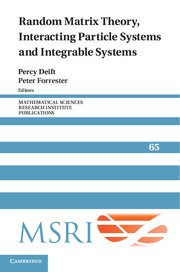Book contents
- Frontmatter
- Contents
- Preface
- Universality conjecture for all Airy, sine and Bessel kernels in the complex plane
- On a relationship between high rank cases and rank one cases of Hermitian random matrix models with external
- Riemann–Hilbert approach to the six-vertex model
- CLT for spectra of submatrices of Wigner random matrices, II: Stochastic evolution
- Critical asymptotic behavior for the Korteweg–de Vries equation and in random matrix theory
- On the asymptotics of a Toeplitz determinant with singularities
- Asymptotic analysis of the two-matrix model with a quartic potential
- Conservation laws of random matrix theory
- Asymptotics of spacing distributions 50 years later
- Applications of random matrix theory for sensor array imaging with measurement noise
- Convolution symmetries of integrable hierarchies, matrix models and τ-functions
- Universality limits via “old style” analysis
- Fluctuations and large deviations of some perturbed random matrices
- Three lectures on free probability
- Whittaker functions and relatedstochastic processes
- How long does it take to compute the eigenvalues of a random symmetric matrix?
- Exact solutions of the Kardar–Parisi–Zhang equation and weak universality for directed random polymers
- Replica analysis of the one-dimensional KPZ equation
- Asymptotic expansions for β matrix models and their applications to the universality conjecture
- KPZ scaling theory and the semidiscrete directed polymer model
- Experimental Realization Of Tracy–Widom Distributions And Beyond: Kpz Interfaces In Turbulent Liquid Crystal
- Random matrices: the four-moment theorem for Wigner ensembles
Random matrices: the four-moment theorem for Wigner ensembles
Published online by Cambridge University Press: 29 May 2025
- Frontmatter
- Contents
- Preface
- Universality conjecture for all Airy, sine and Bessel kernels in the complex plane
- On a relationship between high rank cases and rank one cases of Hermitian random matrix models with external
- Riemann–Hilbert approach to the six-vertex model
- CLT for spectra of submatrices of Wigner random matrices, II: Stochastic evolution
- Critical asymptotic behavior for the Korteweg–de Vries equation and in random matrix theory
- On the asymptotics of a Toeplitz determinant with singularities
- Asymptotic analysis of the two-matrix model with a quartic potential
- Conservation laws of random matrix theory
- Asymptotics of spacing distributions 50 years later
- Applications of random matrix theory for sensor array imaging with measurement noise
- Convolution symmetries of integrable hierarchies, matrix models and τ-functions
- Universality limits via “old style” analysis
- Fluctuations and large deviations of some perturbed random matrices
- Three lectures on free probability
- Whittaker functions and relatedstochastic processes
- How long does it take to compute the eigenvalues of a random symmetric matrix?
- Exact solutions of the Kardar–Parisi–Zhang equation and weak universality for directed random polymers
- Replica analysis of the one-dimensional KPZ equation
- Asymptotic expansions for β matrix models and their applications to the universality conjecture
- KPZ scaling theory and the semidiscrete directed polymer model
- Experimental Realization Of Tracy–Widom Distributions And Beyond: Kpz Interfaces In Turbulent Liquid Crystal
- Random matrices: the four-moment theorem for Wigner ensembles
Summary
We survey some recent progress on rigorously establishing the universality of various spectral statistics of Wigner random matrix ensembles, focussing in particular on the four-moment theorem and its applications.
1. Introduction
This paper surveys the four-moment theorem and its applications in understanding the asymptotic spectral properties of random matrix ensembles of Wigner type. Due to limitations of space, this survey will be far from exhaustive; an extended version will appear elsewhere. (See also [Erdʺos 2011; Guionnet 2011; Schlein 2011] for some recent surveys in this area.)
To simplify the exposition (at the expense of stating the results in maximum generality), we shall restrict attention to a model class of random matrix ensembles, in which we assume somewhat more decay and identical distribution hypotheses than are strictly necessary for the main results.
Definition 1 (Wigner matrices). Let n ≥ 1 be an integer (which we view as a parameter going off to infinity). An n × n Wigner Hermitian matrix Mn is defined to be a random Hermitian n × n matrix Mn = (ξij1≤i, j≤n), in which the ξij for 1 ≤ i ≤ j ≤ n are jointly independent with ξij ≡ ξij (in particular, the _ii are real-valued). For 1 ≤ i < j ≤ n, we require that the ij have mean zero and variance one, while for 1 ≤ i = j ≤ n we require that the _ij have mean zero and variance σ2 for some σ2 > 0 independent of i, j, n. To simplify some of the statements of the results here, we will also assume that the ξij ≡ ξij are identically distributed for i < j, and the ξij ≡ ξ' are also identically distributed for i ≡ j, and furthermore that the real and imaginary parts of ξ are independent. We refer to the distributions Reξ , Im ξ, and ξ' as the atom distributions of Mn.
Information
- Type
- Chapter
- Information
- Publisher: Cambridge University PressPrint publication year: 2014
